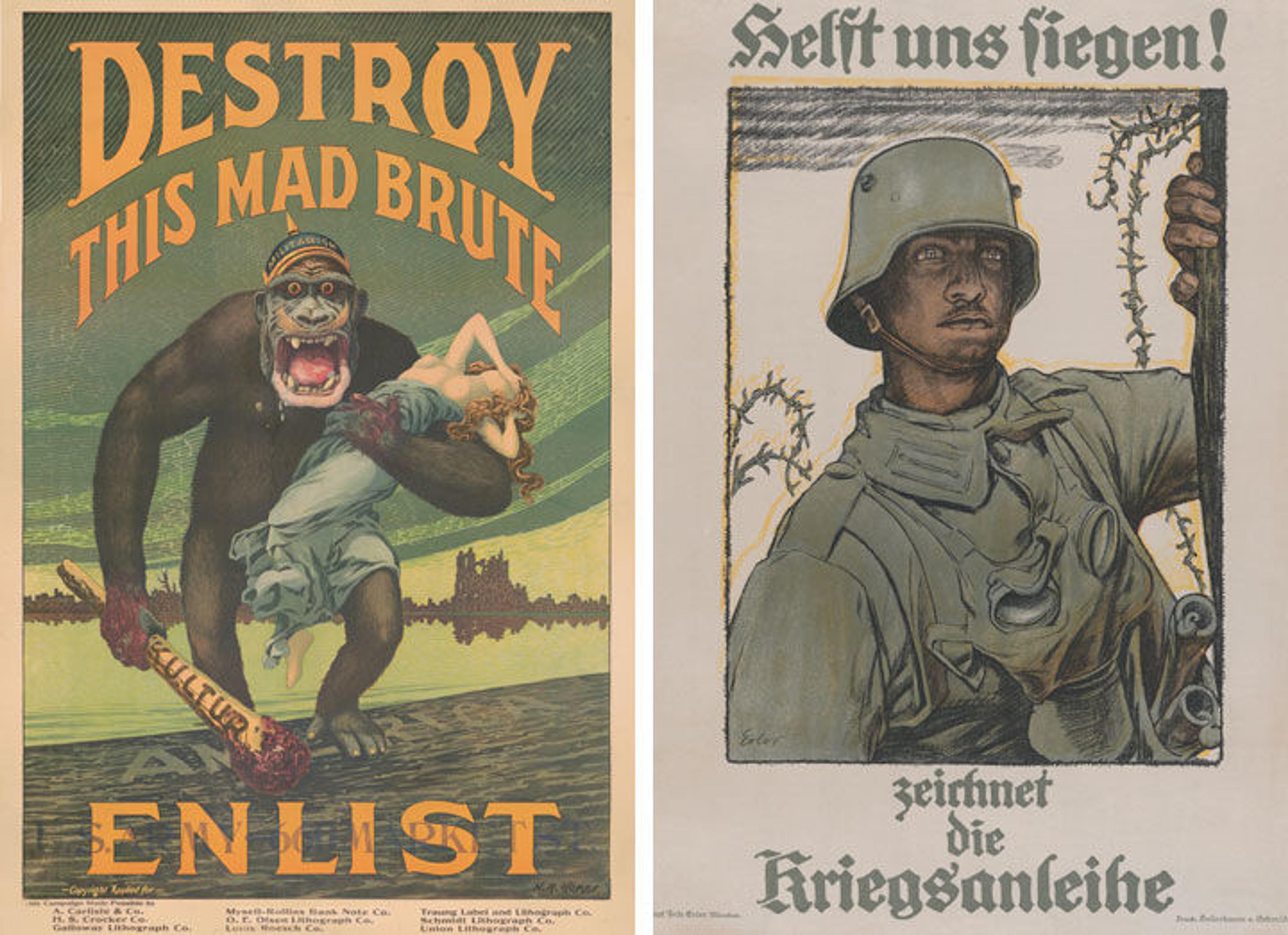Propaganda in the form of posters, postcards, and trade cards flourished during World War I due to developments in print technology that had begun in the 19th century. Governments on both sides of the conflict invested in printed matter that rallied public sentiments of nationalism and support for the war while also encouraging animosity toward the enemy.
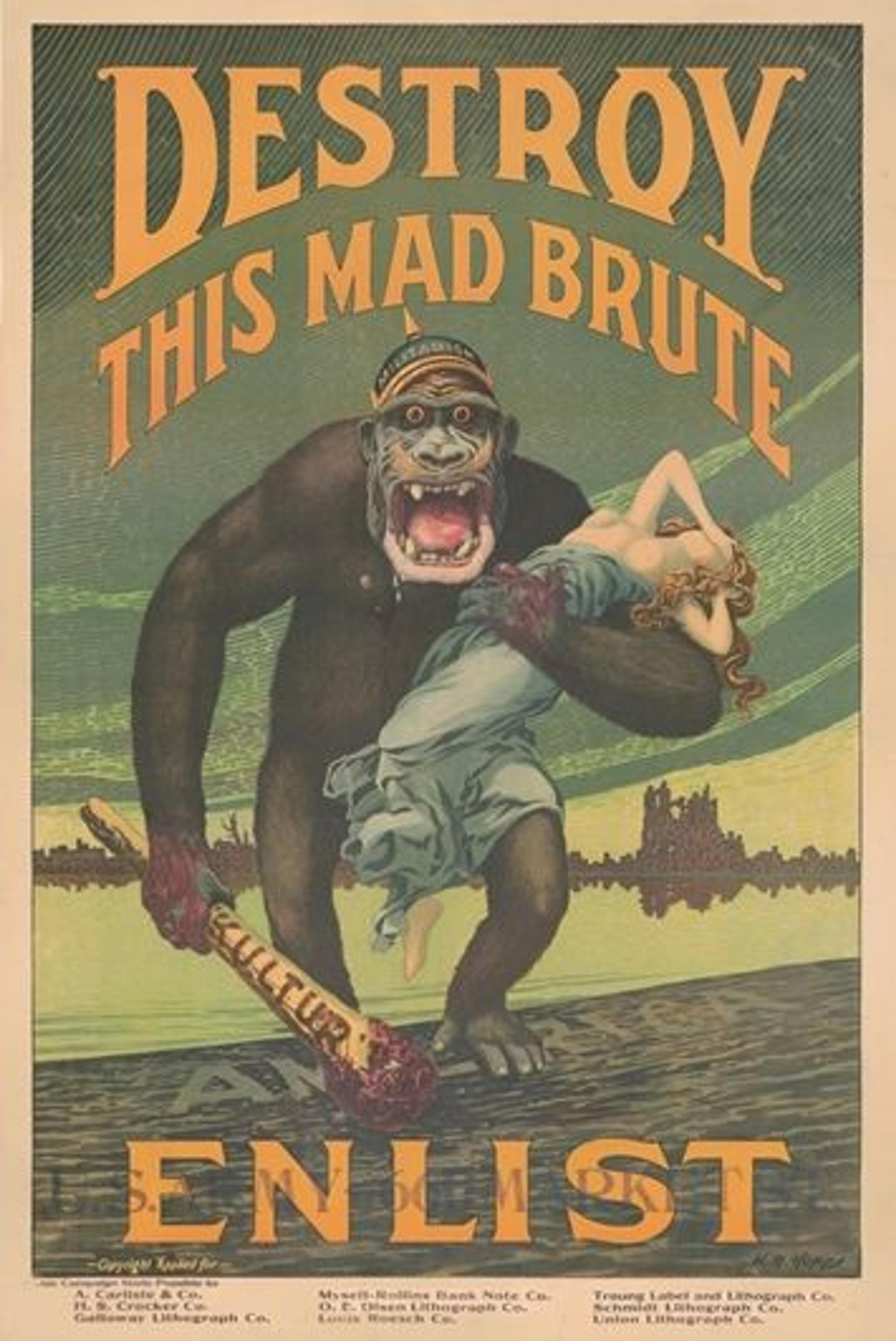
Harry Ryle Hopps (American, 1869–1937). Destroy This Mad Brute: Enlist, 1917. Color lithograph, image: 38 3/4 x 25 5/8 in. (98.4 x 65.1 cm). Collection of Mary Ellen Meehan
During wartime, large-format, full-color posters plastered walls from city streets to classrooms. They mobilized support for the war effort, summoned donations to charities, encouraged participation in war bonds, and publicized victories in notable battles to a broad public. Illustrators of varying renown were called on to produce forceful images whose meaning could be quickly and easily grasped by a diverse audience.
Calling on American men to enlist, Harry Ryle Hopps's poster Destroy This Mad Brute: Enlist (1917) casts Germany as a barbarian who has arrived on U.S. shores, leaving behind a destroyed Europe. The "mad brute" wears a spiked helmet emblazoned with the word "militarism" and dons a mustache suggestive of Kaiser Wilhelm II's whiskers. He has abducted an allegorical figure of Lady Liberty and clenches the bloodied club of German Kultur (culture). The motif of the barbarous enemy abounds in propaganda issued by the Allied forces, and the ape-like figure in particular—a precursor to the title character in the 1933 film King Kong—spoke to an audience familiar with Charles Darwin's theories of evolution.

Fritz Erler (German, 1868–1940). Help Us Win! Buy War Bonds (Helft uns siegen! Zeichnet die Kriegsanleihe), 1917. Color lithograph, image: 22 3/4 x 17 1/2 in. (57.8 x 44.5 cm). Collection of Mary Ellen Meehan
On the German side, Fritz Erler designed Help Us Win! Buy War Bonds (1917) after making studies of soldiers at the front. The man depicted in his poster wears a type of steel helmet introduced by the German army in 1916. The gas mask on his chest, the two "potato-masher" grenades in a pouch dangling from his left shoulder, and the barbed wire that surrounds him are all visual hallmarks of World War I. The artist formed the soldier's pupils into small crosses, harnessing Christian symbolism to cast him as a noble and timeless figure. The poster was produced in three sizes and was also issued as a postcard to promote war bonds to German citizens.
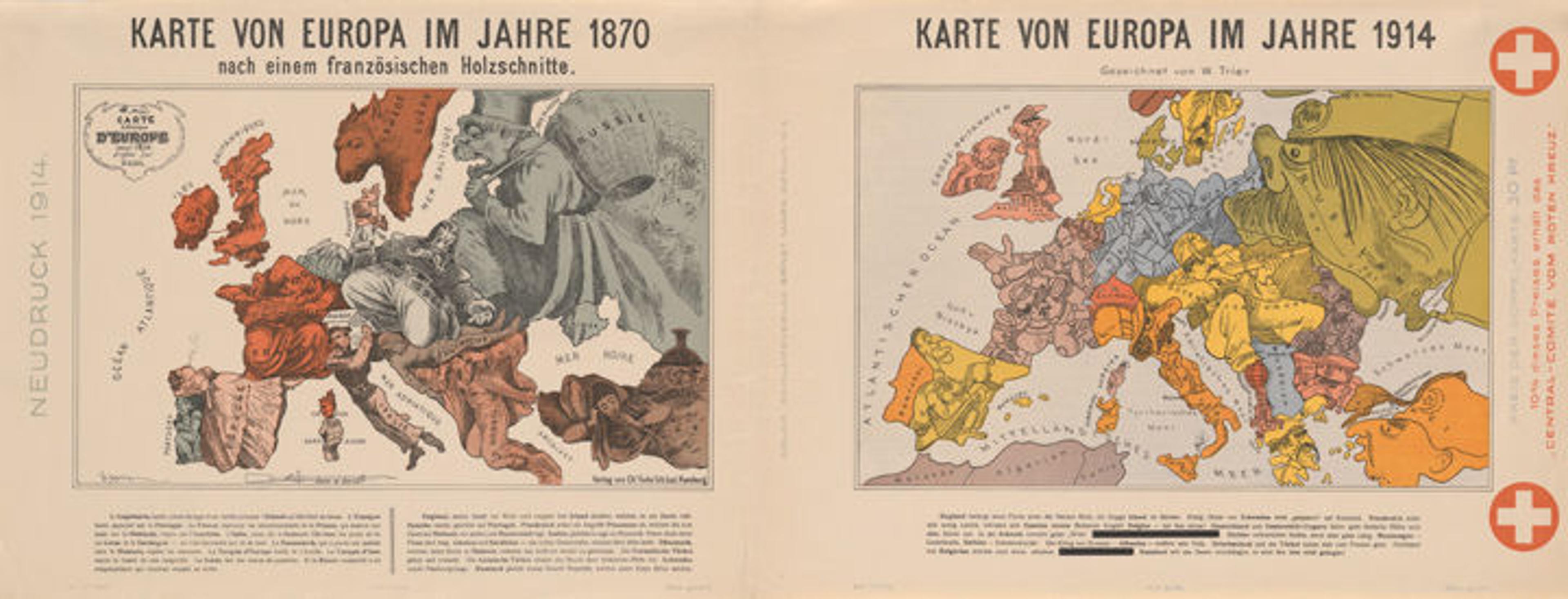
Paul Hadol (French, 1835–1875) and Walter Trier (Bohemian, 1890–1951). Map of Europe in 1870 / Map of Europe in 1914, 1914. Commercial color lithograph, sheet: 14 5/16 x 37 3/16 in. (36.4 x 94.5 cm). The Metropolitan Museum of Art, New York, Gift of Mrs. William O’D. Iselin, 1961 (61.681.9a, b)
Drawing on humor to sway public opinion, French artist Paul Hadol illustrated a satirical map of Europe at the beginning of the Franco-Prussian War (1870–71), from which the Prussian army emerged victorious one year later. In response, German artist Walter Trier produced a map of the region at the outbreak of World War I, with each country similarly cast as a caricature. He depicts Germany and Austria-Hungary as heroic soldiers fending off surrounding nations, each represented by a negative stereotypical figure. A percentage of the proceeds from sales of his map supported the Red Cross.

November 10, from the series Battles of August–November, 1914, 1914. French. Color lithographs, sheet: 4 x 6 in. (10.2 x 15.2 cm). Leonard A. Lauder Postcard Archive. Promised gift, Museum of Fine Arts, Boston
Thanks to their diminutive size, postcards were another ideal tool for circulating propaganda and publicizing wartime events. Like Trier's poster, a series of postcards based on cartoons published in an English magazine uses caricature in comparing the opposing armies to a pair of "scientific wrestlers." The sequence in the spread, published on November 4, 1914, ends on October 26, at the height of the First Battle of Ypres. The postcard issuer included an additional scene (above): the November 10 Battle of Langemarck, represented as a knockout blow.
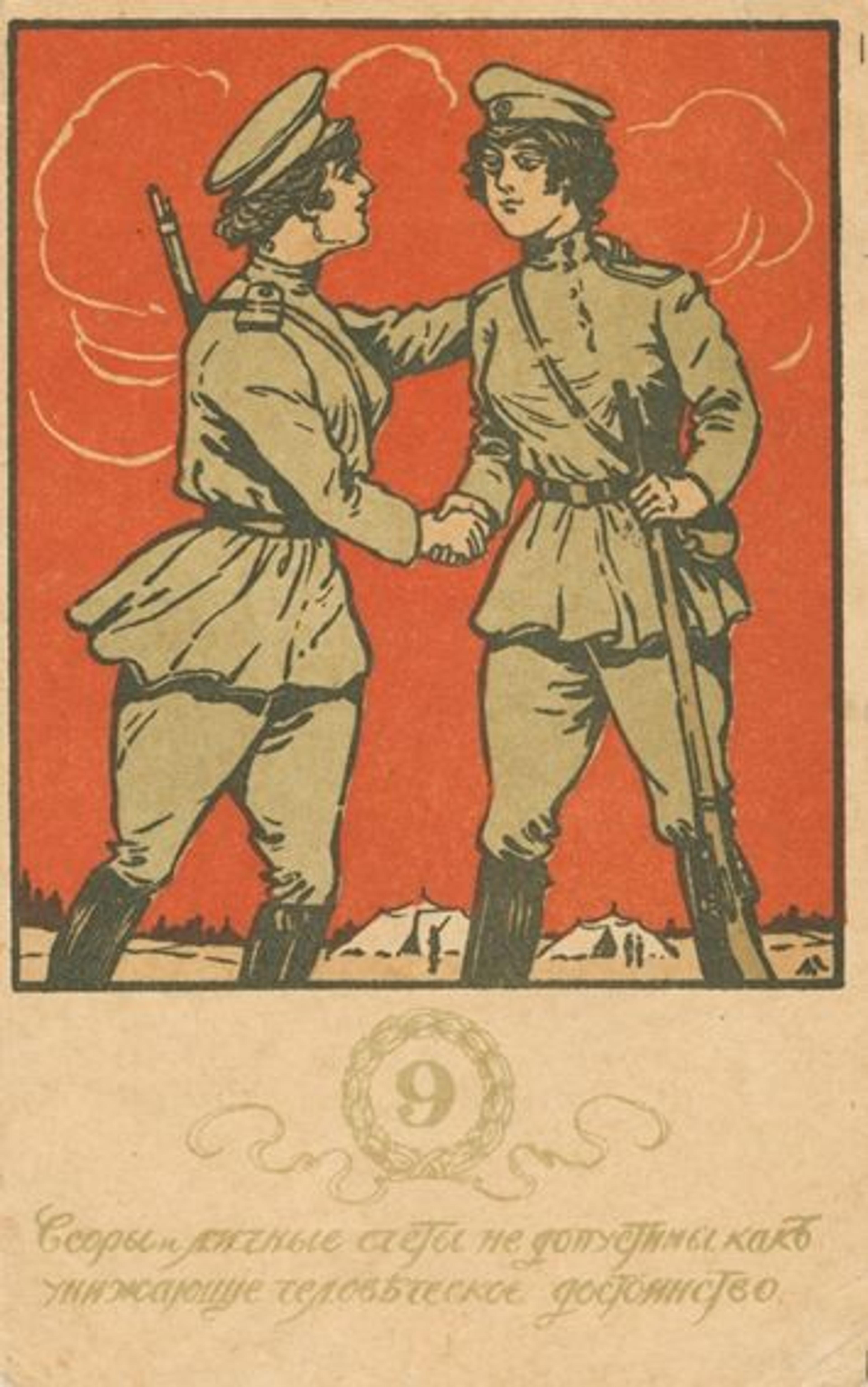
Quarrels and Fights Are Unacceptable, as It Diminishes Individual Dignity, from the series Women Soldiers, ca. 1917. Color lithograph, sheet: 6 x 4 in. (15.2 x 10.2 cm). Leonard A. Lauder Postcard Archive. Promised gift, Museum of Fine Arts, Boston
The provisional government in place in Russia, which controlled the country following the abdication of Tsar Nicholas II and prior to the ascendance of the Bolsheviks in 1917, established all-female combat units in an attempt to inspire war-weary male soldiers and demonstrate the Bolshevik model of equality among citizens. Postcards featuring members of the women's battalions were paired with moralizing captions celebrating qualities such as bravery, unity, and good hygiene.

Carl Otto Czeschka (Austrian, 1878–1960). Central Power Aircraft in Flight, from the series German Armaments, 1915–16. Color lithograph, sheet: 4 x 6 in. (10.2 x 15.2 cm). Leonard A. Lauder Postcard Archive. Promised gift, Museum of Fine Arts, Boston
Other wartime postcards were considered objets d'art. Those designed by Carl Otto Czeschka, a member of the Wiener Werkstätte (a community of artists in Vienna established in 1903 devoted to restoring thoughtful craftsmanship to industrial production), extol German armaments like the aircraft pictured above. The Bahlsen cookie company issued the postcards for the German military postal service (Feldpost), which provided complimentary mail service to soldiers. Their streamlined compositions and color palette also appealed to collectors with a taste for modernist design.
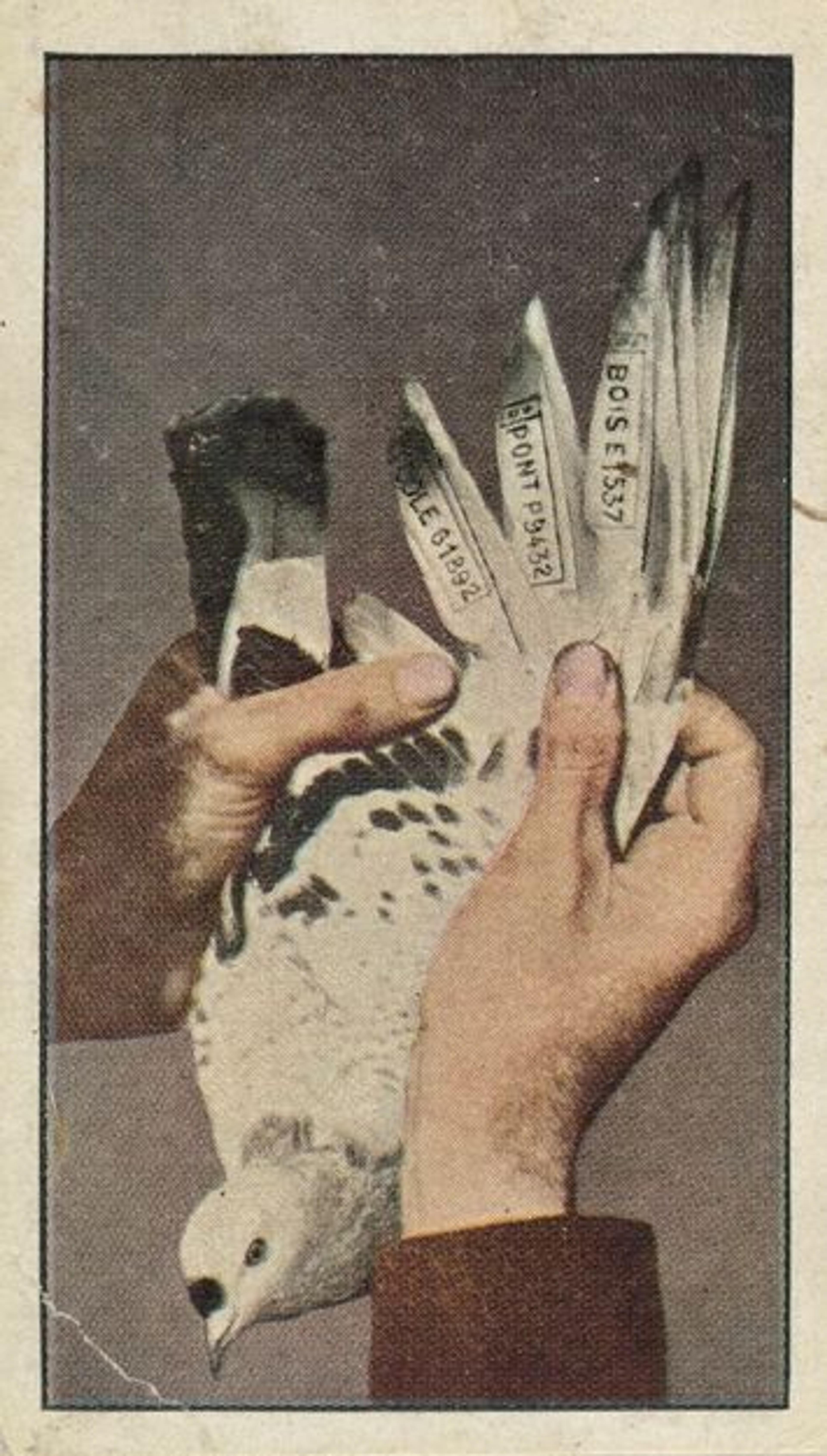
Issued by American Tobacco Company; original photograph by Underwood & Underwood (American). Card No. 74, Belgian Carrier Pigeon, with Its Message in Code, from the World War I Scenes series (T121) issued by Sweet Caporal Cigarettes, 1914–15. Photolithograph, sheet: 2 5/8 x 1 9/16 in. (6.7 x 3.9 cm). The Metropolitan Museum of Art, New York, The Jefferson R. Burdick Collection, Gift of Jefferson R. Burdick (63.350.246.121.1–.250)
Trade cards—antecedents to today's business cards—were a popular means for companies to publicize their products, and often included captivating images to encourage customer loyalty. Trade cards from the Jefferson R. Burdick Collection distributed in packs of Sweet Caporal cigarettes illustrate the unprecedented convergence of modern technologies with traditional wartime tools, such as homing pigeons that deliver messages in code inscribed on their feathers. While such collectables were used for promotional purposes, they also had an educational component and aimed to spread knowledge about all facets of the war.
These posters, postcards, and trade cards may all be viewed through January 7, 2018, in the exhibition World War I and the Visual Arts; many of these works are also discussed in the accompanying issue of The Metropolitan Museum of Art Bulletin.
